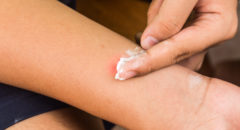
If you are wondering how to remove skin tags safely and effectively at home, the answer is...you don’t. There are risks associated with removing skin tags at home, so you should let your dermatologist examine them to make sure there are no serious problems (such as skin growths that are cancerous).
What are skin tags?
A skin tag, also known as acrochordons or soft fibromas is a harmless growth that typically appears on the skin. These benign (non-cancerous) skin tumors are commonly found on the neck, axilla (under the arm), and groin. Skin tags appear as protrusions of loose skin, usually ranging between 2 mm (.08 inches) to 6 mm (.23 inches) in diameter; they are usually skin-colored, but dermatologists often observe larger darker-colored skin tags.
Why Remove Skin Tags?
It is unlikely that skin tags are painful, but they can be bothersome. Reasons a person may want to remove skin tags include:
- They often become caught on clothing or jewelry.
- There is a possibility that they will bleed.
- They may not be aesthetic (pleasing to look at)
RELATED: Have You Checked Your Skin Lately? It Could Save Your Life
Safety and Effectiveness of At-home Removal Methods
There are a variety of over-the-counter products and methods claimed to remove skin tags including:
Using toothpaste (for skin tag removal) - there are no medical studies that report toothpaste is safe or effective for removing skin tags.
Over-the-counter products - these products use a method called ligation to remove skin tags; a band is wrapped around the stem of the skin tag to cut off the blood supply. As a result, the lesion's cells die. It is then easier to twist or remove the skin tag. Dermatologists sometimes use ligation to remove skin tags. Although skin tag removal at home is possible with ligation, dermatologists do not recommend it as a home remedy.
Skin tag removal cream - salicylic acid and tea tree oil are active ingredients in this product, which may cause a skin condition called dermatitis (irritated, inflamed skin).
A skin tag patch - uses a type of mediation that is supposed to help the skin tag fall off after removal of the patch. This skin tag removal method is not very effective and often causes irritation to the nearby skin.
Freezing applications - these over-the-counter products use chemicals that decrease the skin tag’s temperature, destroying the unwanted skin tissue. The temperature attained by freezing kits available over-the-counter is not as low as dermatologists suggest. The effectiveness of at-home freezing kits depends on how many times you apply them. In clinical settings, dermatologists use liquid nitrogen freezing to achieve lower temperatures that are considered more effective in removing skin tags.
Home remedies – home remedies include the removal of skin tags with products such as vinegar or tea tree oil. These products are said to take several weeks to work, but there is no scientific evidence backing the effectiveness of tea tree oil or vinegar for skin tag removal. Tea tree oil has been shown to cause an allergic reaction in some people.
RELATED: One Key Question Can Help Spot Skin Cancer
Risks of At-Home Removal
While you may be tempted to try at-home removal of your skin tags, there are risks including:
- An infection
- Scars
- Excessive bleeding
When To See the Doctor
It is important to speak with a dermatologist about safe removal options if you are sure you want the skin tags removed. Note, never attempt any method of cutting skin tags off.
Cutting skin tags off, particularly larger lesions, is linked with a risk of bleeding and infection. You should always see your dermatologist or another healthcare provider before attempting to remove skin tags at home.
A medical professional can recommend a safe and effective way to remove skin tags. The doctor will also examine skin tags to ensure there are no signs or symptoms of complications associated with skin tags such as underlying hormonal problems.









